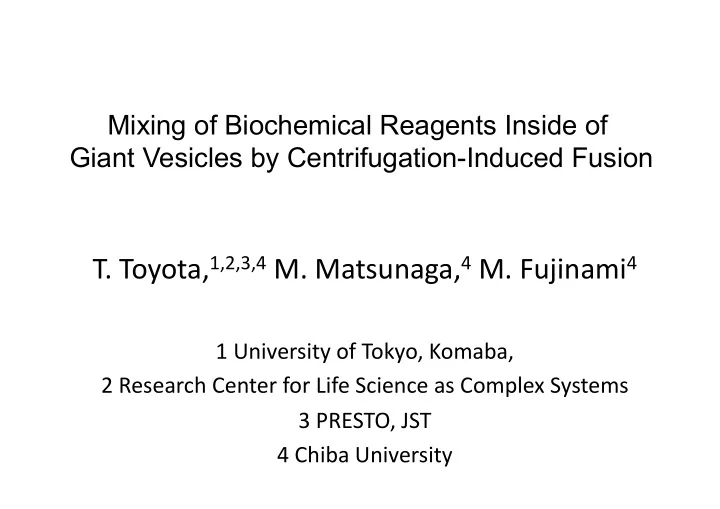

Mixing of Biochemical Reagents Inside of Giant Vesicles by Centrifugation-Induced Fusion T. Toyota, 1,2,3,4 M. Matsunaga, 4 M. Fujinami 4 1 University of Tokyo, Komaba, 2 Research Center for Life Science as Complex Systems 3 PRESTO, JST 4 Chiba University
Giant vesicles Closed lipid bilayer membrane (lipid capsule) 1,2-dioleoyl-3- sn -glycero-phosphocholine Φ 40nm ~ 100 µ m Differential interference contrast micrograph Cross-section of giant vesicles ConstrucLon of biomimeLc reacLon field for observing/measuring biochemical reacLon network in sense of analyLcal chemistry!!
GV preparaLon (BoUom‐up type) Film‐swelling ElectroformaLon Bangham et al. Angelova et al. • Mostly mulLlamellar, • Unilamellar, spherical nesLng, aggregated etc • High encapsulaLon raLo • Low encapsulaLon raLo (by microinjecLon etc) • Large number of GVs • Small number of GVs Phase contrast micrograph Differential interference contrast micrograph
W/O emulsion centrifugaLon method (Top‐down type) Pautot (2003) Water-in-oil emulsion • Single‐wall (unilamellar) • Large number of GVs Inner leaflet Centrifugation • Engineering leaflet asymmetry Noireaux (2004) outer leaflet • Gene expression of Hemolysin‐GFP complex in GVs Fluorescence micrograph Aggregated Spherical Adhered 20 µ m • Does encapsulaLon raLo of content reach 100 %? • How is the populaLon of GVs in shape distributed?
CentrifugaLon principle Centrifugation Principle with Stokes’ Law Frictional force Frictional force = 3 π d η v d : diameter of particle, η : viscosity of solution, v : speed of descending particle 1 π d 3 ( σ - ρ ) r ω 2 Centrifugal force = 6 d : diameter of particle, σ , ρ : density of particle and solution, Centrifugal force r , ω : rotation radius and speed
Typical recipe W/O emulsion TrisHCl buffered solution containing sugars (1 M) and fluorescein Centrifugation Giant vesicles TrisHCl buffered solution containing glucose (1 M) 35 µ m Fluorescein‐containing GVs formed by centrifugaLon •
Flow cytometric (FCM) analysis on GV shape Flow cytometer (EPICS ALTRA) Scheme Detector for side light scatter and fluorescence Irradiation laser Ar + Laser Forward light scatter Detector for Fluorescein ~ Cross-section area forward light scatter ~ Volume Sample From website of Bechmann Coulter
Quantitative population analysis on GV shape K. Nishimura, T. Hosoi et al ., Langmuir , 25 , 10439 (2009). Inner water region allophycocyanin ( Ex: He-Ne laser 633 nm, Em: 650-670 nm Bandpass ) Vesicular membrane BODIPY-tagged phospholipid ( Ex: Ar + laser 488 nm, Em: 515-545 nm Bandpass ) Fluorescence intensity of vesicular membrane = Number of fluorophore per GV: N HPC Fluorescence intensity per one fluorophore Molar Ratio of cholesterol and fluorophore to phospholipids: r chol , r HPC Surface area of polar heads of phospholipid and cholesterol 0.65 nm 2 , 0.28 nm 2 Lipid membrane area / µ m 2
Nominal lamellarity of GV Lipid membrane area per volume Nominal lamellarity = Lipid membrane area per volume of an unilamellar vesicle W/O emulsion centrifugaLon method Film swelling method Slope: 3/2 Slope: ‐‐ Inner water region /fL Nominal lamellarity: 10 ~ 20 Nominal lamellarity: 2 ~ 3 Lipid membrane area / µ m 2 Almost all GVs were spherical and their nominal lamellarity was quite low (2~3).
MoLvaLon for mixing internal contents Enzymatic Reactions in Cells Compartmentalized by micrometer-sized closed membrane • Confinement effect • Surface activity of membrane etc Construction of biomimetic reaction space inside of closed lipid membrane Subject ・ Space inside of GV ~ 1 fL → depletion of substrates ・ Addition of non-permeable substrates into GVs is difficult. Our strategy: Vesicle Fusion or Hemi-fusion for mixing internal contents
Mixing internal contents inside of GV CentrifugaLon S Fusion S P E S + + E E E P S + + E E Hemi-fusion
Why does it work? Number density of lipid molecule in membrane Oil phase molecules Membrane fluidity for transformaLon at contacLng site
Summary High encapsulaLon raLo of content! • Lipid conc. in oil phase • Temperature during centrifugaLon • Density difference • 10 mol% cholesterol – EncapsulaLon raLo (so far) : 63% Flow cytometry revealed – Almost all are spherical and have low nominal lamellarity (2 or 3). GVs fused/hemi‐fused for mixing internal content – Mixing of internal content of GV was realized without any additives for fusion/hemifusion by collecLng GVs through centrifugaLon.
Acknowledgements Analytical Chemistry Lab. in Chiba University Mr. Tomohiro Hosoi Prof. Koichi Oguma Information Bioscience Lab. in Osaka University Mr. Kazuya Nishimura Dr. Takeshi Sunami Prof. Tetsuya Yomo Prof. Hiroaki Suzuki More for W/O-EC GV… Poster session (Tomorrow ) A. Shiga (P203) Manipulation of W/O-EC GV by optical trapping T. Furuya (P204) W/O-EC GV dynamics observed by reflective interference contrast microscopy
Recommend
More recommend